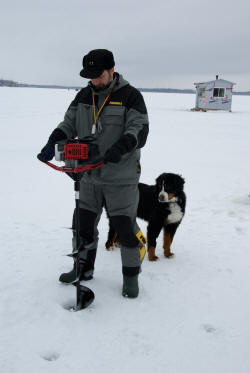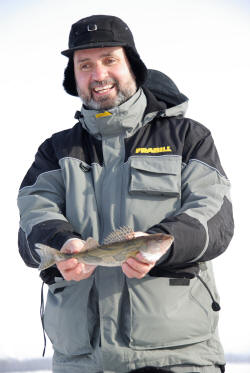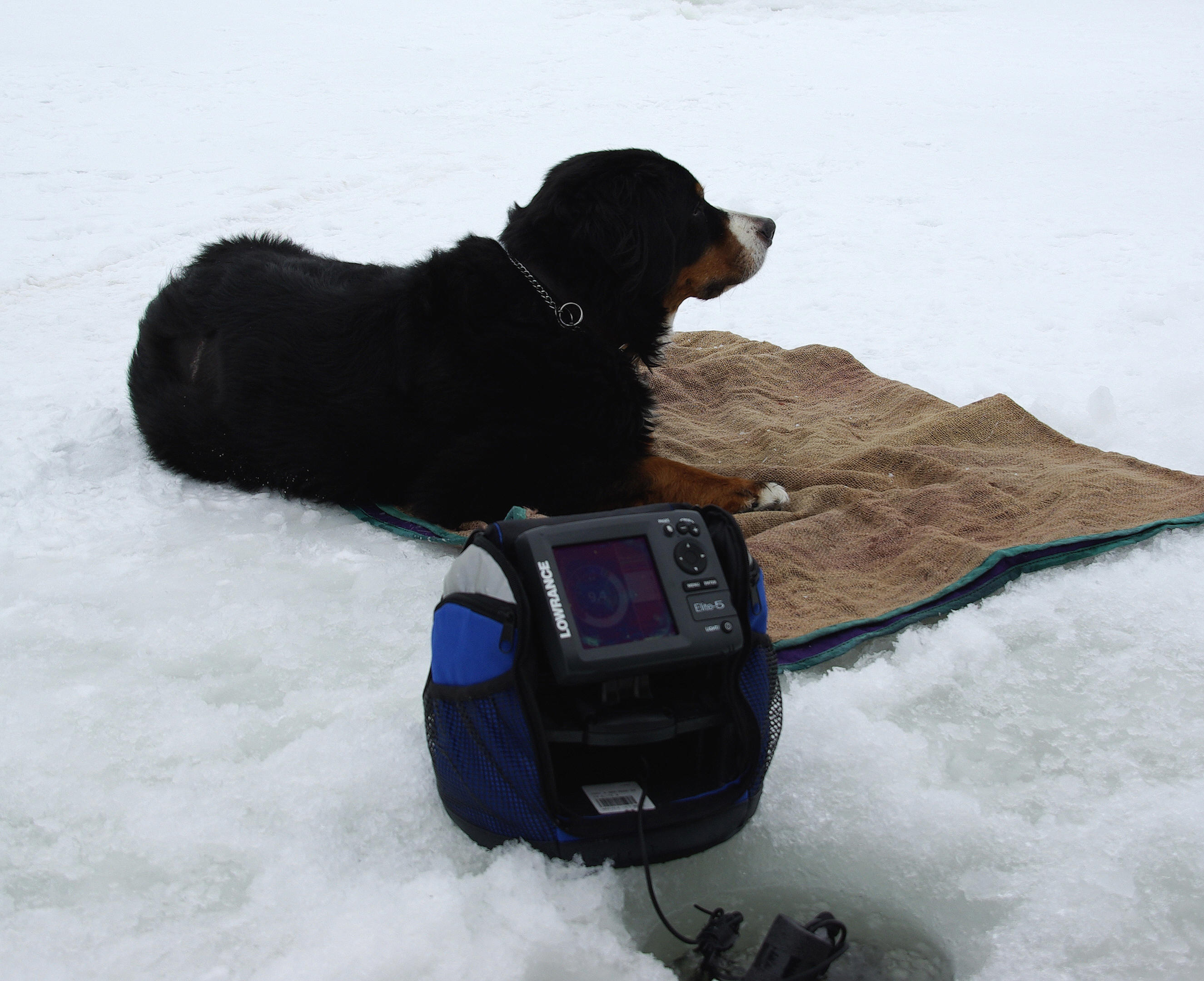 Gearing
Up for the Ice
Gearing
Up for the Ice
By Lawrence Gunther Euteneier /
Feel the Bite!
Anyone who is considering or has
already taken up the sport of
ice fishing has wrestled with
the idea of purchasing three of
the more pricey “must-haves”. 1,
some form of portable shelter;
2, a power auger; and 3, a
flasher or sonar device. While
the list of essentials has
remained more or less steady
over the past number of decades,
these three more recent
innovations, some might argue,
have now made it on to the “must
have” list. And then there’s the
really big ticket 4th item – the
ATV or
Snowmobile – the ultimate
“toy”…
There’s no doubt that the
introduction of flashers and
sounders designed specifically
for the ice has led to an
increased interest in ice
fishing. However, it wasn’t so
long ago that fishers would use
the absence of light inside
their wooden fishing shacks to
do with their eyes what they can
now do with their electronics.
IN fact, earliest ice fishing
traditions had Inuit fishers
kneeling on the ice and using
the hood of their parkas to
create a light barrier around
the whole, all while holding a
feathered but hookless jig tied
to a length of sinew in one hand
and a fish spear in the other.
While peering down ice holes may
work, sonar does make ice
fishing somewhat more
entertaining, and used to its
full potential, such as when
combined with GPS and some good
maps, more likely to result in
fewer fishless days.


I’m often somewhat amazed that
seasoned fishers perceive ice as
some sort of impervious shield
that renders fish witless about
what’s taking place just meters
above their heads. Whether there
is ice or not, fish are still
capable of being aroused and
ultimately spooked. Pounding
from heavy boots, clatter from
equipment being unloaded,
vibrations from gas-powered
engines, wholes filled with
intense light suddenly opening
up above their once silent ice
and snow covered worlds, all
offer ample evidence that things
are not as they should be. I’m
not advocating ninja training or
fishaflage; however, “Out of
sight, out of mind” doesn’t
apply on ice. The more “kit” one
drags around the more reasons
fish have for getting over their
initial curiosity and switching
to the defensive.
Try to keep movement over bare
ice to a minimum, use snowy
patches to minimize shadow
flickers below, and drill all
your anticipated wholes in one
shot. Punch a line of wholes
that extends across known
structure leading from shallow
to deep. Don’t be in a rush to
scoop all the slush out of the
drilled wholes ; leaving it in
minimizes light penetration
below. The challenge is to cause
as little disruption and get
baits down as quickly as
possible before curious fish
grow weary and adopt a
“wait-and-see” mentality.
For sure, ice fishing is a
social event, but it also
involves team work. While large
shelters, permanent or not, can
seem like a great idea for
hosting ice fishing gatherings,
their efficiency for aiding in
finding fish is minimal. A group
of friends spreading out over
the ice can serve to more
effectively determine where fish
are staging. Once fish have been
found, moving closer together
will increase everyone’s chances
of catching fish. Only then
should one go ahead and set up a
shelter or wind break, depending
on temperatures. However, it
would seem that the use of such
enclosures has gone full circle
with many now electing to employ
“wearable shelters” (warm
clothing) thanks to a number of
ice fishing companies who have
begun marketing fashionable and
functional extreme weather
outerwear designed specifically
for the ice fisher. The new Ice
Suit from Frabill is a
light-weight breathable
two-piece shell that offers
fishers layering flexibility for
maintaining ideal comfort –
excellent given the wide range
in temperatures that now seem to
typify our winters.
It’s more often the case ice
fishing involves heading out to
known community fishing wholes
and joining in on the action.
There’s nothing wrong with
selecting to fish along side
others already set up on the
ice. They are there for a reason
– it’s often where the fish are.
If you already have pre-selected
likely fish-holding structure
using tools such as Google Earth
or detailed maps such as those
offered by Navionics, or you
took the time to locate and
create way points during the
soft water season using your GPS
unit on your boat, then by all
means, try your hand. This is
how community wholes first
start.
Fishing over or next to
structure is just as important
in the winter as it is in the
summer. Because the water will
have “turned” prior to freezing
over, the temperature and oxygen
levels will be the same at all
depths. This means fish who have
spent their summers seeking out
specific temperature zones now
have the chance to roam wherever
they please. Downloading the
Navionics ap on to your I-Phone
can assist in locating structure
under the ice on unfamiliar
bodies of water.
The Lowrance Elite 5 Ice Machine
combines the ability to utilize
Navionics maps with a sounder /
flasher, all contained within
one unit safely stored inside
it’s own padded carrying case
along with a light-weight
rechargeable battery. While some
might claim that the traditional
flasher style of sonar display
is the only technology that
allows the fisher to see a jig’s
movement in real time, sounders
that offer both a flasher and
traditional sounder display such
as the Lowrance Elite 5 provide
the best of both worlds;
including a time –laps sequence
of images.
For sure there are times when I
head out on the ice equipped to
“rung and gun”. Rapala’s new
Sherpa series of inexpensive
pop-up shelters can be easily
transported using the shoulder
straps built into the carrying
bag. A soft-sided ice rod combo
carrying case with 4-6
pre-rigged combos, a manual
6”-8” auger, and a 5-gallon
bucket containing gear fitted
with a lid for sitting pretty
much covers all my needs.
However, once ice has begun to
thicken, adding a power auger
such as Rapala’s new “Black Ice”
line of light-weight machines to
the list of essentials continues
to allow one to cover territory
without working up a significant
sweat, and later chill.
Even if power augers and
electronics aren’t in your
budget, it’s still possible to
catch fish. The newer style of
ice rods such as the Frabill Bro
Quick Tip series have built in
indicator tips that flex under
the slightest pressure from even
the lightest bite, a handy
alternative to removing mitts in
order to feel the bite. When
outdoor temperatures allow, or
when sheltered from the wind or
enclosed inside a heated
shelter, my favourite method is
to use slightly stiffer rods
such as those available through
the Frabill Ice Hunter series. I
hold the rod so it can freely
tip up and down by simply
balancing the outfit on my index
finger while keeping the palm
and thumb of the same hand
hovering just over top of the
rod’s grip. The handle will
apply pressure on my palm when a
fish is drawing down on my bait,
and the rod will tilt upwards
and touch my thumb on those
occasions when fish swim up with
my offering. Just as
importantly, this style of grip
allows me to follow actively
jigged baits back down without
establishing tension in the line
that takes away from the natural
fall of the bait.

Some of my favourite artificial
baits include Lindy’s original
Viking Spoon and their Darta.
Their new Slick Jigs are also
excellent. When fishing any jig,
tie on using a loop knot to
allow maximum movement to the
jig. However, try to avoid your
jig spinning -- nothing turns
off a fish quicker than a jig
turning 360’s. Braded line,
although more susceptible to ice
build up, manages to absorb line
twist much more efficiently than
mono or fluoro. Finally,
Rapala’s Jigging Raps are
consistent producers, especially
when the centre treble is tipped
with a live minnow.
Naturally, the presentation you
choose will depend largely on
the fish species being pursued.
But, don’t hesitate to ask
others what works locally. Ice
fishing really is a sport that
involves people sharing. Whether
it’s an offer by a neighbour to
punch some holes for a stranger,
or passing on advice on where
and when to go, there just
doesn’t seem to be the level of
secrecy that one normally
associates with those fishing
open water.
Most community holes can often
be reached with a vehicle, but
avoid parking along side
everyone else. Nothing’s worse
than a collection of heavy
trucks parked together and then
someone drilling a “pressure
release” hole near by resulting
in water gushing on to the
surface.
Remember, wearing a flotation
suit on newly formed or
potentially treacherous ice,
such as those made by Salus
Marine, and carrying ice pics is
always a good idea. Wearing a
personal flotation device is
also perfectly acceptable.
There’s no such thing as safe
ice.
Ontario Ice
Fishing




